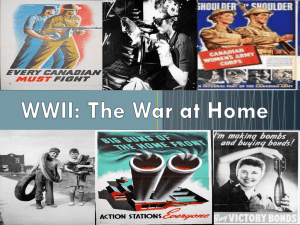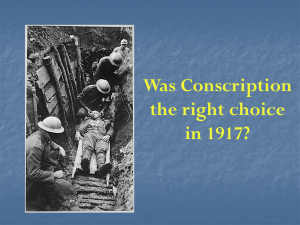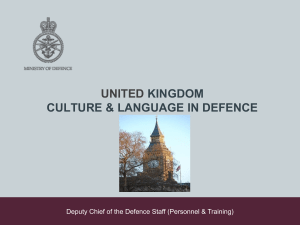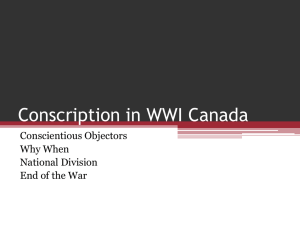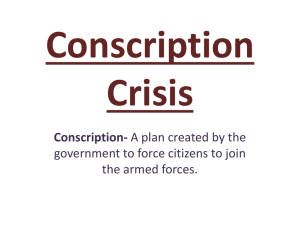Professional Armed Forces
advertisement
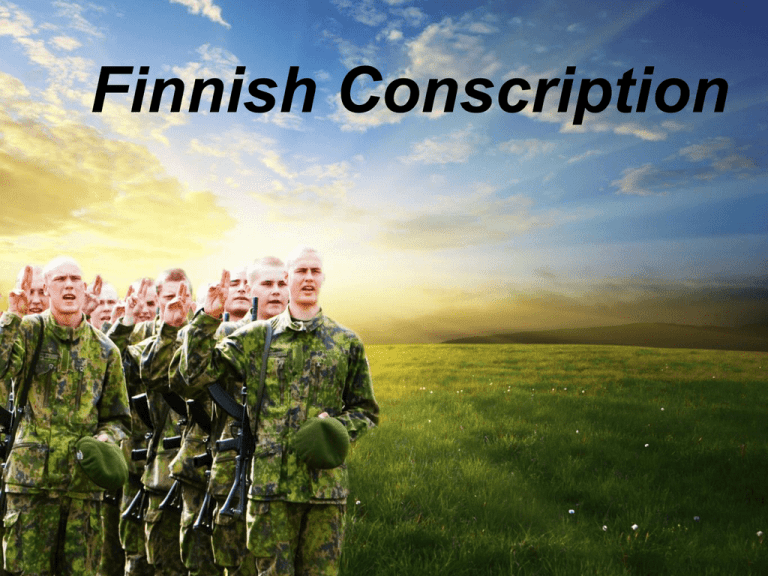
Finnish Conscription Finnish military services Future of the conscription system working group • 350,000 men reserve • Chairman Risto Siilasmaa • 30,000 men of age annually • Group composition • 79% of male population completed training in 2009 • On a scale from 1-5 – will to defend the country 4,0 – overall rating for training time 4,0 – satisfaction with the training 3,5 – satisfaction with conscript leaders 3,7 – satisfaction with employed trainers 3,9 – Appointed by the chairman and minister of defence – No civil servants – Critical, experienced and entrepreneurial team • Key principles – Question everything – Nothing is sacred – Present all findings, positive and negative – Be concrete 2 Evaluation of the alternative systems 1. Exceeds minimum requirements for operational capability? – Relative to operational purpose – How to measure objectively? 2. Expense to the society in direct budgetary costs and, more importantly, in gross economic costs tolerable? – How to measure indirect benefits and costs? 3. Other factors affecting the overall fit for purpose evaluation? – Certain benefits and costs are impossible to measure 3 Background: Conscription or Professional Armed Forces? The Defence of The Territory Crisis management Not allied Members of NATO 40% 10% 45% 50% 39% 62% 16% 20% The way towards professional armed forces 28% 40% 34% 40% 17% 1990 2000 2010 Future of the Finnish Defence Cost analysis Conscription 250,000 Selective Conscription Voluntary Conscription 16% Professional Armed Forces 60,000 -2.7 billion -4.9 billion Welfare effects No return -8.6 billion COST OF DEFENCE MODELS Evaluated Dimensions • Labour force • Capital Costs • Gross Domestic Product • Tax Revenue • Household Demand • Total Cost for Society Professional Armed Forces Need for infrastructure 26,000 more people 60,000 Conscripts 19,000 Personnel 15,000 4.9 Billion/year 2.7 Billion/year Salaries + 1.5 Billion Materiel + 0.4 Billion Rents + 0.2 Billion Operating costs + 0.1 Billion –> + 2.2 Billion / year THE FINANCIAL SITUATION OF THE FINNISH MILITARY IS NOT SUSTAINABLE 2.7 Mrd€ Personnel costs +2 % / annum Operations and real estate Cost increase of materiel +4-8% / annum 2010 2015 2020 Massive aging of army materiel between 2010-2020 Future of the Finnish Defence Operational capability CONSCRIPTION <> CONSCRIPTION Unsuccessful Conscription Functional Conscription 37,5 hours working weeks 5 – 6 training days a week, no limited working hours Training of individuals Producing wartime units No measurement of training results Measurement of training results against hard targets Conscripts used for secondary tasks (cheap labour) Training war time units as priority No clear purpose Clear purpose (Defence of the homeland) Conscription Training System - Production of Wartime Units APR MAY JUN JUL AUG SEP OCT NOV DEC JAN FEB MAR APR MAY JUN JUL SPECIALISTS LEADERS BRANCH and JOB TRAINING UNIT TRAINING 9 weeks RESERVE UNIT SPECIALISTS LEADERS WINTER INTAKE In January UNIT TRAINING 9 weeks BASIC TRAINING SUMMER INTAKE In July BASIC TRAINING WINTER INTAKE In January MAR BASIC TRAINING JAN FEB RESERVE UNIT BRANCH and JOB TRAINING + Refresher Training for Reserve Units SPECIALISTS LEADERS SIZE OF THE RESERVE 30 000 24 000 21 000 men start pass 17 000 allocated Wartime reserve 15v 250 000 10v 170 000 Future of the Finnish Defence General conclusions Dimensions Professional Force or Conscription Total Cost for Society Mission of the Defence Forces Giving up conscription: WHY? • The mission of the Defence Forces is changed from defence to crisis management • Continuous forced uncoordinated cuts in the Defence Forces spending • Training results not sufficient in relation to capability requirements • No need for big reserves • Difficulties getting motivated conscripts Professional vs Conscription Professional Force Conscription No recruitment base Recruitment Limited working Hours Effective use of the week No reserves for defence Reserves for defence Crisis management tasks Defence of the country Higher costs Cost-effective Weak link to society Positive effects on society Future of the Finnish Defence Conclusions for Finland Participation in International Crisis Management Support for other Authorities Defence of Finland Meaningful and motivating for Conscripts Economy Effects on Society 23 Professional Armed Forces Bde area of operations 30 x 50m2 per 1 km2 Positive effects on society - Connects the different actors in society - Promotes social values, national defence will and social peace - Provides young men and women with versatile skills, some of the most significant of which include leadership training, driver training and first aid training - Teaches social and group skills - Prevents social exclusion - Facilitates immigrant integration - Promotes public health - Provides data and material for research - Produces a military reserve that can also support other authorities - Produces personnel for crisis management tasks - Acts as a recruitment channel for the Defence Forces and other authorities. 1 The conscription system be maintained • The entire male age group fit for service undergoes military service training • There are no grounds for a transition to professional forces • Military alliance would not have considerable impacts on the conscription system • In the next few years, the Defence Forces must undergo a structural reform, which at the same time will secure the position of the conscription system • Military service remains voluntary for women • Voluntary military service for women is supported especially by providing more information 2 Financial latitude is created to avoid constant forced cost cuts • Investigating the possibilities of transitioning partly to a four-month term of service • Introducing other reforms that create financial latitude Operating models are developed further 3 • Developing a conscript information system that provides the Defence Forces with more information about the conscripts and vice versa • Utilising the call-up events as a platform, which allows for the individual, various authorities and actors to meet and exchange information that benefits both the individual and the different actors • Developing the initial survey and feedback systems in a way that allows for giving open feedback and learning from good practices • Developing a centralised social reservation register 4 The position of conscripts is improved • Improving the financial standing of conscripts • Connecting conscription with the lifelong educational system where credit is given for the skills acquired during military service in civilian studies and the working life as well as possible • Developing different reward systems for conscripts • Promoting healthy lifestyles among conscripts • Implementing the "timeout" operating model in all municipalities 5 Resources are allocated • Supporting instructors of conscripts in their demanding work and especially paying attention to supporting young instructors • Increasing the number of the training personnel in military units that train conscripts Thank you!
